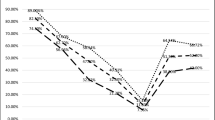Abstract
In all cancer specialities, there has been much debate about the best follow-up regime. The provision of a service that meets high standards whilst being cost-effective is increasingly pertinent. The objectives of the study were to examine: whether routine follow-up facilitates early diagnosis and recurrence; whether there is a cohort of patients who require a more intensive follow-up regime; whether follow-up should be customised to individual patients. A total of 1,039 consecutive outpatient consultations were prospectively analysed in a multicentre study. All adult patients who had undergone multidisciplinary, multimodality management for head and neck cancer were included. The case mix was representative of all head and neck tumour sites and stages. Suspicion of recurrence was noted in 10% (n = 96/951) of patients seen routinely. This rose to 68% (n = 60/88) for the subset of patients who had requested an appointment. Most recurrences were found within the first follow-up year (n = 64/156, 54%). Only 0.3% (n = 3/1,039) of asymptomatic patients attending routine appointments were suspected of having a recurrence, and two (0.2%) were found to have an actual recurrence following investigation. Of the total number of patients reporting a new suspicious symptom, recurrence was suspected in 56% (n = 152/270). Patients thus had a 98.1% sensitivity to raising suspicion for a recurrence based on the reporting of new symptoms with a 99.6% negative predictive value. Our data show that the efficiency of the current follow-up regime at detecting suspected recurrence of head and neck cancer is low, suggesting the need for a customised, more focused follow-up regime, tailored to individual cases. Patient education and close relationships with clinicians and allied health-care professionals are essential for early diagnosis and management of cancer recurrence. Follow-up regimes within the first year should be most intensive as recurrence is most likely within this time, and it serves to alleviate patient anxiety in the early post-treatment period. More research needs to be carried out to investigate the role of patient self-reporting and surveillance of cancer recurrence.



Similar content being viewed by others
References
Boysen M, Lövdal O, Tausjö J, Winther F (1992) The value of follow-up in patients treated for squamous cell carcinoma of the head and neck. Eur J Cancer 28:426–430
Boysen M, Natvig K, Winther F, Taujsö J (1985) Value of routine follow-up in patients treated for squamous cell carcinoma of the head and neck. J Otolaryngol 14:211–214
Vikram B, Strong E, Shah J, Spiro R (1984) Second malignant neoplasms in patients successfully treated with multimodality treatment for advanced head and neck cancer. Head Neck Surg 6:734–737
de Visscher AV, Manni JJ (1994) Routine long-term follow-up in patients treated with curative intent for squamous cell carcinoma of the larynx, pharynx and oral cavity. Does it make sense? Arch Otolaryngol Head Neck Surg 120:934–939
Lester SE, Wright RG (2009) ‘When will I see you again?’ Using local recurrence data to develop a regime for routine surveillance in post-treatment head and neck cancer patients. Clin Otolaryngol 34:546–551
Bröyn T, Fröyen J (1982) Evaluation of routine follow-up after surgery for breast carcinoma. Acta Chir Scand 148:401–404
Cochrane JPS, Williams JT, Faber RG, Slack WW (1980) Value of outpatient follow-up after curative surgery for carcinoma of the large bowel. BMJ 280:593–595
Dewar JR, Kerr GR (1985) Value of routine follow-up of women treated for early carcinoma of the breast. BMJ 291:1464–1467
BAO-HNS Effective Head and Neck Cancer Management (1998) 1st consensus document. British Association of Otorhinolaryngologists, Head and Neck Surgeons. Royal College of Surgeons of England, London
BAO-HNS Effective Head and Neck Cancer Management. (2002) 3rd consensus document. British Association of Otorhinolaryngologists, Head and Neck Surgeons. Royal College of Surgeons of England, London
Scottish Intercollegiate Guidelines Network (SIGN) (2006) Diagnosis and management of head and neck cancer: a national clinical guideline
Improving outcomes in head and neck cancers: the manual, 2004. National institute for health and clinical excellence
Marchant FE, Lowry LD, Moffitt JJ, Sabbagh R (1993) Current national trends in the post-treatment follow-up of patients with squamous cell carcinoma of the head and neck. Am J Otolaryngol 14:88–93
Meier JD, Oliver DA, Varvares MA (2005) Surgical margin determination in head and neck oncology: current clinical practice. The results of an International American Head and Neck Society Member Survey. Head Neck 27:952–958
Spector GJ, Sessions DG, Lenox J, Newland D, Simpson J, Haughey BH (2004) Management of stage IV glottic carcinoma: therapeutic outcomes. Laryngoscope 114:1438–1446
Spector JG, Sessions DG, Haughey BH, Chao KS, Simpson J, El Mofty S et al (2001) Delayed regional metastases, distant metastases, and second primary malignancies in squamous cell carcinomas of the larynx and hypopharynx. Laryngoscope 111:1079–1087
Cooney TR, Poulsen MG (1999) Is routine follow-up useful after combined-modality therapy for advanced head and neck cancer? Arch Otolaryngol Head Neck Surg 125:379–382
Virgo KS, Paniello RC, Johnson FE (1998) Costs of post-treatment surveillance for patients with upper aero-digestive tract cancer. Arch Otolaryngol Head Neck Surg 124:564–572
Conflict of interest
None to declare.
Author information
Authors and Affiliations
Corresponding author
Appendices
Appendix 1: Data collection proforma

Appendix 2: Patient survey

Rights and permissions
About this article
Cite this article
Kothari, P., Trinidade, A., Hewitt, R.J.D. et al. The follow-up of patients with head and neck cancer: an analysis of 1,039 patients. Eur Arch Otorhinolaryngol 268, 1191–1200 (2011). https://doi.org/10.1007/s00405-010-1461-2
Received:
Accepted:
Published:
Issue Date:
DOI: https://doi.org/10.1007/s00405-010-1461-2




